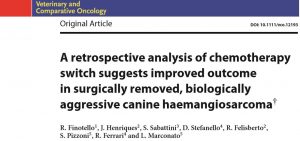Paper review: ‘switch’ chemotherapy in canine splenic haemangiosarcoma post-splenectomy

This article, published last year, is quite exciting: dealing, as it does, with a common situation in our day to day caseload.
It is an oft-quoted statistic that <10% of splenic haemangiosarcoma cases will survive one year from spelnectomy even if no metastases are grossly apparent at the time of surgery and using doxorubicin-based chemotherapy. A better protocol would be welcomed.
‘Switch’ chemotherapy involves a relatively intensive initial course of treatment followed by prolonged metronomic chemotherapy.
Numbers of cases are relatively small: 10 dogs in the ‘switch’ group receiving maximum-tolerated dose doxorubicin-based chemotherapy (4-6 cycles of doxorubicin) followed by metronomic, low dose cyclophosphamide plus one of firocoxib, meloxicam or piroxicam and 12 dogs in the control group receiving only the doxorubicin-based initial course. As such this would be best described as a pilot study.
Presumed cyclophosphamide-induced cystitis was observed in 2 dogs: in which case cyclophosphamide was discontinued and chlorambucil was substituted.
Most dogs in the control group died around the 200 day mark. Although, interestingly, most of those that survived 300 days were still alive at 800 days. However, in the switch group over 50% of dogs survived beyond 1300 days -which I would describe as remarkable considering mean age at onset was 8.9 years.





